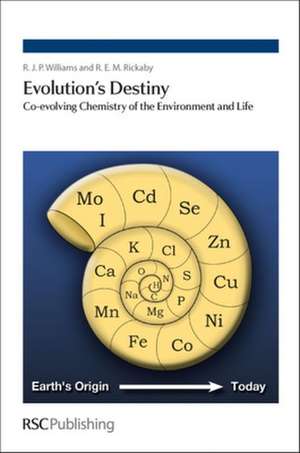Evolution's Destiny: Co-Evolving Chemistry of the Environment and Life
Autor Robert J. P. Williams, Ros Rickaby, R. J. P. Williamsen Limba Engleză Hardback – 30 iun 2012
Preț: 497.65 lei
Preț vechi: 540.92 lei
-8% Nou
95.24€ • 103.41$ • 79.100£
Carte indisponibilă temporar
Specificații
ISBN-10: 1849735581
Pagini: 344
Dimensiuni: 161 x 245 x 31 mm
Greutate: 0.78 kg
Editura: Royal Society Of Chemistry
Cuprins
Notă biografică
Textul de pe ultima copertă
Traditionally, evolution has been viewed solely from a biological fitness perspective, with genes determining how life takes shape in response to the environment. Furthermore, until the arrival of man, life had little or no apparent influence on the environment. Recent advances in our understanding of the Earth's geochemistry and knowledge of the geological record almost from the origin of the Earth have lead to the consideration that, beyond the "survival of the fittest" species, evolution has been occurring on larger, chemical, scale. This book demonstrates that biology and geochemistry have continually influenced each other in the co-evolution of the Earth and all life. In particular there were several essential controls over the bulk inorganic elements in cells which had major consequences later in evolution. The main driving change during evolution was that oxygen released from cells led to novel inorganic elements in the environment. The new elements then interacted with the cells and ultimately the cells came to utilise them in stages. The large scale changes of environmental chemicals ceased about 400 million years ago. At that time the chemical conditions of the environment for present-day life existed. Subsequent changes of organisms were by random "Darwinian" processes and led eventually to the development of a refined brain in man. Man has then been able to restart chemical and physical changes in the environment. The outcome of this remains unknown, but history implies that changes in living organisms must result from these novel chemical experiments with the environment. This highly original scholarly work will be of interest to chemists and biologists alike. Anyone with an interest in evolution, the environment, or natural history will find this a fascinating and inspiring subject.
